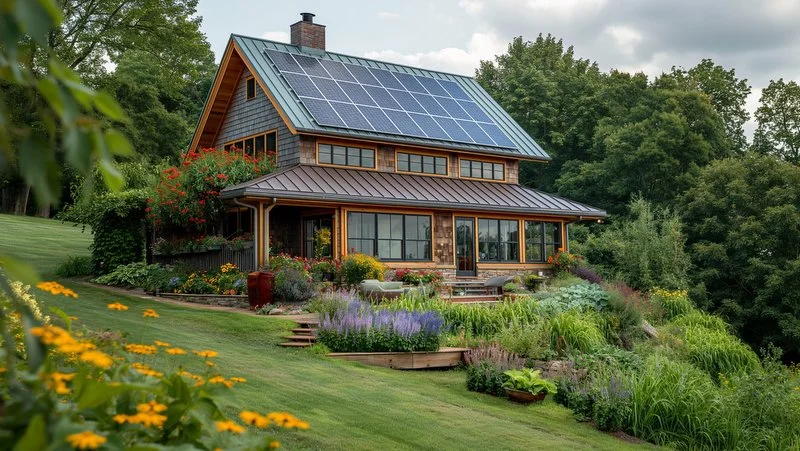An Eco-friendly lifestyle is becoming more popular conscious choices that benefit both the planet and our personal well-being. Our sustainable living guide is designed to simplify how to co-existence with our planet by making daily adjustments.
No need to change everything about your lifestyle now, but start with incremental steps to benefit both the planet and your well-being. Let’s continue to learn more!
Table of Contents
1. Energy Efficiency
2. Sustainable Home Improvements
3. Green Transportation
4 Consumption Habits
5. Plant-Based Diet
6. Green Work
7. Wrap-Up
8. FAQ
Energy Efficiency

By reducing the amount of energy we consume, we cut down on the greenhouse gas emissions which in turn help to reduce the climate change. Efficient energy utilization is therefore a suitable approach to creating a sustainable future. If you start to consider to use appliances that is energy efficient for your home, not only they help in minimizing our carbon footprint, but could potentially increases the market value of your house by 2-8% (Ref: Studies Show Better Resale Value for Energy-Efficient Homes), especially if your house is certified. This brings economic advantages to you, starting to be convinced, are you?
Additionally, energy efficient appliances for the home can improve indoor air quality, resulting in a healthier living space for both you and your family.
Renewable Energy Adoption
If you haven’t realize already, our Sun is the main source of energy for all living things. We can harness that energy through through solar panels which transforms the Sun’s light into usable energy. The good things about this is that, the Solar system requires minimal upkeep, reduce the carbon emission significantly, roughly around one ton of carbon emissions per year, and save your electricity bills by (on average) $120-150 per month!
The transition to the green power source has becoming really easy to access now thanks to solar panels. As the market grew over the past years, the costs are reduced, enabling a greater number of people and communities to transition to green power sources. This isn’t limited to just generating electricity. It includes incorporating solar energy into home heating solutions too, allowing your residence to utilize renewable sources for its complete energy needs day and night.
Smart Thermostats and Energy Management

One great option for energy efficient appliances for the home is a “Smart Thermostat”. A smart thermostat can understands your preferences even more precisely than you do. These intelligent thermostats are engineered to log the data of your daily routines and adjust the temperature in your room accordingly while maximize energy efficiency and reduce your energy costs.
This smart device is called IOT (Internet of Things) which comes with Wi-Fi connectivity that enables remote control via your smartphone to adjust or config the heating and cooling systems. Most importantly is that it is proven to potentially save as high as 10% on the electric expenses, due to the smart thermostat uses just enough and not excessive energy.
Most of the smart thermostat also comes with the Energy Monitoring function to see in real-time how you utilize power. Definitely fun for those who enjoy to observe how the device help you saving the energy while living an eco-friendly way of life.
Additionally, the best ideal temperature is 72°F (22°C) for Winter and 78°F (25°C) for Summer. For more information, go on to this article: Best Thermostat Temperatures & Settings for Summer & Winter.
Energy-Efficient Lighting Choices
Another smart choice for energy efficient appliances for the home is LED light bulbs. Not only do these advanced lights save energy compared to conventional bulbs, but their life span is much much longer. It’s true that a LED light bulb costs more, but consider this: a conventional (incandescent bulbs) light bulb’s life span is around 5,000-10,000 hours, but an LED light bulb can last as long as 50,000-100,000 hours, that’s 10 times! Less time to replace means less expense. They’re also generating less carbon emissions, good for the planet!

Go for LEDs and commit to eco-friendly practices while saving the time that need for you to replace a conventional light bulbs and endorsing sustainability. This straightforward change is an effective strategy in promoting conservation of resources and financial savings.
Sustainable Home Improvements
Transforming your home into an efficiency living space is a great way for a sustainable lifestyle. By improving the insulation, you could cut energy use for heating and cooling by as much as 45%, ensuring comfort in any climate while significantly reducing electricity usage.

Making the switch to energy efficient appliances for the home that conserve energy and lower carbon emissions—it helps protect the earth’s natural resources. These steps contribute to living harmoniously with the earth, fostering an environmentally responsible existence.
Home Insulation
Wrapping your home in eco-friendly insulation materials is like giving the planet a tender embrace. Materials like wood fibre, hemp and straw are often considered the most environmentally friendly insulation. Not only those material provides superb insulation capabilities but also delivers extra advantages such as managing moisture and offering resistance to fire.
Stay away from toxic home insulation materials such as polyurethane spray foam insulation, rigid foam with flame retardants, or insulation that contains asbestos or formaldehyde. All of these materials contain chemicals that are health hazards.
Taking basic steps such as putting in draught stoppers or sealing gaps between floorboards can substantially enhance the energy efficiency of your living space.
Microwave vs Oven
It should be no surprise that some kitchen device burns up more energy than the other while achieving the same goal. For example, using microwaves instead of ovens. Microwaves generally is used for only a few seconds to minutes, while most people, on average, use an oven for around 10-20 minutes. Thus, microwaves consume less energy than ovens.

By choosing an appropriate devices, you can save energy and cut down on your annual energy bill. This demonstrates how minor adjustments can lead to substantial effects in terms of both conservation and cost.
Eco-Friendly Cleaning Solutions
Choosing natural cleaning products allows for a pristine home environment without detriment to the broader ecosystem. These eco-friendly options allow you to avoid harmful chemicals that can degrade air quality and contaminate water sources.
By using biodegradable cleaning agents made from organic, non-synthetic materials, your efforts contribute towards maintaining cleanliness in your living space while ensuring minimal impact on the environment.
Green Transportation
Let’s move out of the living space and go into the transportation section with electric vehicles and public transportation systems. These choices can significantly reduce carbon emissions, contributing to a more sustainable environment for everyone.

Choosing environmentally friendly options for travel – whether it’s your daily commute or going on a holiday – is an impactful approach to endorse sustainability practices and actively fight against climate change.
Electric Cars and Charging Infrastructure
Electric vehicles or EV are paving the way to an eco-friendly future, free from the harmful emissions associated with traditional gasoline cars. Right now, the main issue is insufficient of the charging stations, it’s so hard to find in some place, doesn’t it?
However, as EV becoming more popular and gaining in sales everyday, so does the expansion of charging networks which is making it easier to find charging stations all over the country. If you look at the trend here: U.S. Public and Private Electric Vehicle Charging Infrastructure, you will clearly see that the trend raised significantly over the past years to support the demand in EV market. This surely will make the EV owner more convenience to find charging stations nearby in the upcoming future.
These vehicles emit no air pollution and can operation on renewable energy sources. For example, you could power your house’s electricity with solar power system, and use some of those energy to power your EV, making it a truly green cycle of energy, while costing literally zero dollar!
Public Transportation and Carpooling
By participating in ride-sharing or using public transportation, we demonstrate our commitment to the environment. Carpooling and taking transit helps to ease traffic congestion, diminish greenhouse gas emissions, and streamline our daily travel. Such collective measures lead to wider benefits like improved air quality and fostering a more sustainable environment that all members of the community can appreciate.
Biking and Walking for Short Distances
Choosing the scenic route for brief journeys can be more than just a pleasant experience. Opting to cycle or walk reduces pollution, enhances road safety, and fosters closer community ties. Every pedal push and footstep is an advance toward creating an eco-friendly environment, illustrating that often the most environmentally conscious choice is simply going by bike or on foot.

Additionally, we can’t resist in mentioning that cycling or walking is, wait for it, good for your health!
Consumption Habits
Every day, the decisions we make have the potential to impact our environment. Opting for a lifestyle that is mindful of consumption means taking deliberate actions to lessen our ecological footprint. Whether it’s cutting down on food waste or selecting sustainable clothing options, each intentional decision contributes to a more sustainable way of living which not only aids in conserving our planet but also supports the well-being of our communities.
Reducing Food Waste
The timeless adage ‘Waste not, want not’ is especially pertinent when it comes to food. How many times did you bought some grocery, put them in the fridge, forgot about it and before you know it, some of the food has gone bad?
Planning meals ahead of time is a straightforward method to minimize food waste, which in turn conserves energy and resources. Additionally, we can convert potential waste into delectable, eco-friendly meals by inventively reusing components such as vegetable peels and overripe fruits. This approach helps transform what would otherwise be discarded into valuable culinary creations.

Now, we understand that this change in habit does require time and dedication. If you don’t do on a daily basis, you’ll eventually forgot about it. Therefore, let’s start by putting a reminder like a note on your fridge or a cupboard, to remind you about your meal plan.
Sustainable Fashion Choices
By nurturing and repairing our attire, seeking out previously owned garments, and endorsing brands that prioritize eco-friendliness, we contribute to a significant decrease in textile waste. This approach fosters an industry where the importance of sustainability is held on par with aesthetic appeal in fashion—a medium that expresses not just our personal style but also our stance towards global environmental consciousness.
Plant-Based Diet
Let’s admit it, people often underestimate the significant impact that our food choices have on Earth’s well-being. Adopting a diet centered around plants as well as practicing water conservation stand as fundamental components of sustainable living, which can greatly diminish our environmental footprints and safeguard vital resources for generations to come.
Benefits of Eating Less Meat and Dairy
Our meals come with a narrative, one frequently accompanied by considerable greenhouse gas emissions and an impactful environmental footprint—particularly the food items derived from meat and dairy sources. When we opt for plant-based choices in our diet, we indulge in dishes that are not only tasty but also healthier.
This can be as simple as dedicating one day a week to abstain from meat and/or for a daily meal composed entirely of plants can substantially diminish our carbon footprint, thereby making a meaningful difference.
Water-Saving Tips
Water is an essential resource that necessitates our collective efforts to preserve it for the good of the environment. Taking straightforward steps such as shutting off the tap during tooth brushing, utilizing water-efficient devices, and repairing any leaks can lead to considerable daily savings in water consumption, which accumulates to a substantial impact over an extended period.
Embracing practices that conserve water guarantees its availability for everyone today and into the future. This ensures we safeguard this crucial resource through responsible use.
Green Work
Adopting sustainability practices extends beyond our homes, encompassing our schools and workplaces as well. By embracing digital solutions to diminish paper waste or opting for eco-friendly methods of commuting, we can significantly impact the health of our environment in all aspects of daily life.
Paper Reduction and Digital Solutions
In the era where digital communication reigns supreme, there is little to no reason to continue our heavy reliance on paper. By adopting digital document management systems and making use of platforms such as Slack and Trello, we can turn our offices into environments that use minimal paper, thereby preserving natural resources and saving energy.
Eco-Friendly Commuting Options
Choosing to ride a bike, go on foot, or utilize public transportation for our everyday journeys is a strong demonstration of dedication to sustainability. These modes of transportation are not just eco-friendly and instrumental in lowering carbon emissions. They also enhance our general health, confirming that environmentally conscious decisions benefit our well-being.
Environmentally Friendly School Supplies
Teaching our kids sustainability practices shapes the future of Earth. Instilling lifelong values of responsibility and conservation, we can equip them with eco-friendly school essentials such as reusable lunch boxes instead of plastic bags, fostering an environmentally conscious mindset from a young age.
Key Takeaways
- From Solar panels to LED bulbs, can reduce emissions, improve health, and save money.
- Better insulation and energy-efficient appliances, are key to lowering bills and better impact on environment.
- EV, public transit, or cycling, helps cut carbon emissions and healthier.
Wrap-Up
To achieve sustainable living, every bits counts—from the energy-efficient light bulbs to eco-friendly transportation. By embracing the steps outlined in this guide, we weave together a lifestyle that not only benefits the environment but also enables a better living as well as reducing the costs. Let’s turn the vision of a healthier planet into a reality, one eco-friendly choice at a time.
Frequently Asked Questions
How to live an eco-friendly lifestyle?
Embarking on an eco-friendly lifestyle can begin with actions such as steering clear of single-use plastics, engaging in recycling efforts, curbing food waste, practicing water conservation and working towards neutralizing your carbon emissions. Contributing to environmental initiatives, patronizing sustainable companies and participating in the democratic process through voting are additional ways to foster a positive ecological influence.
How much can I save by switching to LED light bulbs?
Switching to LED light bulbs could lead to considerable savings on your energy bills and reduce the need for regular replacements, thanks to their reduced energy consumption and extended durability.
Bid farewell to steep energy costs and the hassle of constantly changing bulbs!
Are smart thermostats worth the investment?
Certainly, by learning your habits and modifying temperatures as needed, smart thermostats have the potential to reduce heating and cooling expenses by up to 10% annually, thus representing a valuable investment.
Can I really make a difference by walking or biking short distances?
Indeed, opting to use a bicycle or go on foot for brief excursions can diminish pollution levels, enhance road safety and nurture community spirit.
It certainly has an impact!
What are some simple ways to reduce my water usage?
It’s simple to cut down on your water consumption: just switch off the faucet when you’re brushing your teeth, ensure that dishwashers and laundry machines are operated only with full loads, and promptly repair any leaks in your home.
By taking these steps, you will not only conserve water, but also play a significant role in supporting broader efforts aimed at water conservation.

